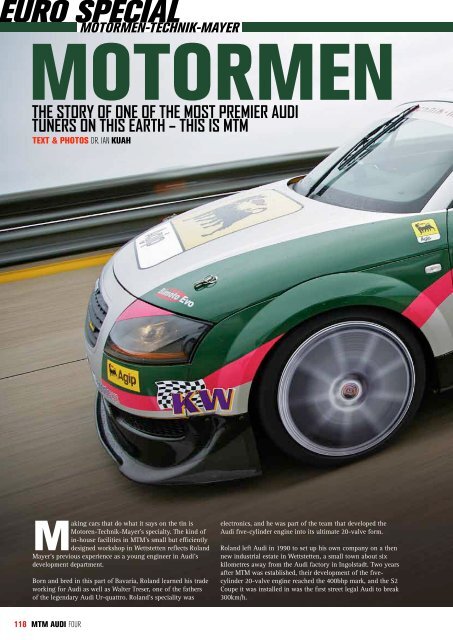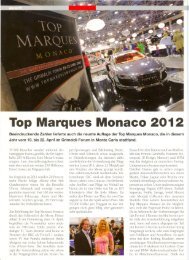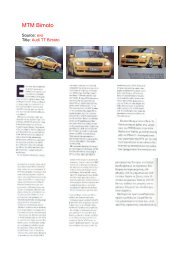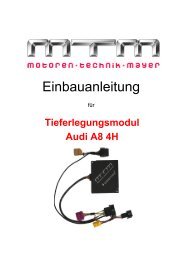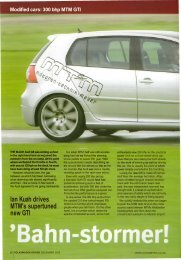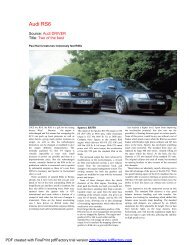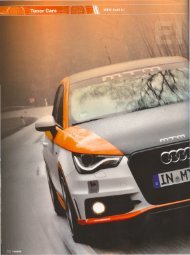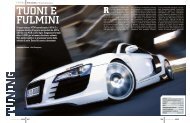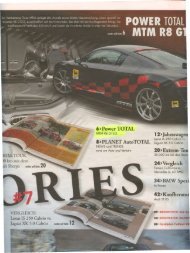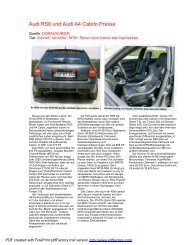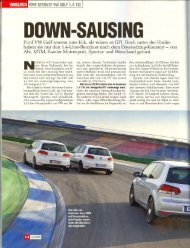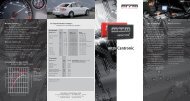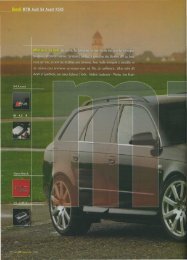euro special - MTM
euro special - MTM
euro special - MTM
Create successful ePaper yourself
Turn your PDF publications into a flip-book with our unique Google optimized e-Paper software.
uro <strong>special</strong><br />
MoToRMeN-TechNik-MAyeR<br />
MoToRMeN<br />
The sTory of one of The mosT premier Audi<br />
Tuners on This eArTh – This is mTm<br />
TexT & PhoTos Dr. Ian kuAh<br />
Making cars that do what it says on the tin is<br />
Motoren-Technik-Mayer’s <strong>special</strong>ty. The kind of<br />
in-house facilities in <strong>MTM</strong>’s small but efficiently<br />
designed workshop in Wettstetten reflects Roland<br />
Mayer’s previous experience as a young engineer in Audi’s<br />
development department.<br />
Born and bred in this part of Bavaria, Roland learned his trade<br />
working for Audi as well as Walter Treser, one of the fathers<br />
of the legendary Audi Ur-quattro. Roland’s <strong>special</strong>ity was<br />
118 <strong>MTM</strong> Audi Four<br />
electronics, and he was part of the team that developed the<br />
Audi five-cylinder engine into its ultimate 20-valve form.<br />
Roland left Audi in 1990 to set up his own company on a then<br />
new industrial estate in Wettstetten, a small town about six<br />
kilometres away from the Audi factory in Ingolstadt. Two years<br />
after <strong>MTM</strong> was established, their development of the fivecylinder<br />
20-valve engine reached the 400bhp mark, and the S2<br />
Coupe it was installed in was the first street legal Audi to break<br />
300km/h.
Since then, the firm has always been game for setting new<br />
top speed records with its cars, and tries to participate in<br />
every Nardo event run by the German magazines Auto Bild<br />
Sportscars and Auto Motor & Sport.<br />
Roland is known for lateral thinking, and his problem was<br />
that you needed over 600bhp to break the 350km/h barrier.<br />
No Audi motor in those days came close to that in street legal<br />
form, so Roland’s solution was to design a twin-engined car<br />
based on the Audi TT.<br />
The twin-engined <strong>MTM</strong> Bimoto that took part in these events<br />
for many years started off with two four-cylinder turbo engines<br />
tuned to 326bhp each, for a total of 652bhp, and set a record<br />
of 374km/h at the AM&S top speed event at Nardo in 2003. By<br />
2007, the car’s power had grown to over 1,000bhp, allowing<br />
it to reach 393km/h at the Papenburg test track in Germany,<br />
establishing a new record for that test track.<br />
One of the development aids that make <strong>MTM</strong>’s facilities the<br />
envy of most other tuners is the bespoke cooling tower that<br />
Roland designed and installed at great cost when he expanded<br />
his workshops in 2001.<br />
The refrigeration units pump freezing cold air via hoses to the<br />
intake systems of cars on the two four-wheel-drive rolling roads.<br />
Ramming refrigerated air into the intake tracts ensures that intake<br />
temperatures stay low and intercoolers do not saturate. Because<br />
peak engine output remains optimal and consistent over multiple<br />
power runs, fine adjustments can be made to the ECU mapping<br />
without having to deal with wildly fluctuating parameters.<br />
On that score, <strong>MTM</strong> is sometimes called upon to help with<br />
development work for other tuners. For instance, they developed<br />
and build the bi-turbo Audi V8 for the Gumpert Apollo.<br />
In real world testing, <strong>MTM</strong> employs world renowned professional<br />
drivers like Walter Rohrl and Armin Schwarz, as well as Seat Cupra<br />
Champion and former <strong>MTM</strong> mechanic Florian Gruber.<br />
As I have learned in the near 20 years I have known Roland Mayer<br />
and <strong>MTM</strong>, many of his friends are either long-term customers or<br />
Audi engineers, but the common thread is their love for cars. This<br />
month, I am happy to present an exposé of some of <strong>MTM</strong>’s finest<br />
works to the current Audi lineup – the four rings of power from<br />
Ingolstadt are in good hands!
NARDO<br />
CALLING<br />
500bhp And 600nm in A 320km/h fronT-wheel<br />
drive Audi hATchbAck – mTm go over The Top<br />
First from <strong>MTM</strong> – the ultimate go-faster A1, a wild<br />
idea conceptualised when <strong>MTM</strong> first received wind<br />
about Audi’s A1 Quattro. What really gave this idea<br />
legs however, was the invitation from Auto Motor<br />
& Sport magazine to their Nardo top speed shootout event in<br />
May 2011.<br />
Immediately, the team began refining an A1 for the specific<br />
purpose of obliterating the competition. When <strong>MTM</strong> place<br />
the two magic words, “Nardo Edition” on one of their cars, it<br />
means that it has gone to Nardo, guns blazing, and come away<br />
with an impressive top speed number. This may be the smallest<br />
car that <strong>MTM</strong> has ever entered in such an event – but it is by<br />
no means the slowest.<br />
As with any other tuning house, shoehorning big engines<br />
into small cars is a common pastime at <strong>MTM</strong>. In the case of<br />
the <strong>MTM</strong> A1 Nardo Edition, rather than a big displacement<br />
V8 lurking under the bonnet, one finds the award-winning<br />
120 <strong>MTM</strong> Audi a1 narDo eDItIon<br />
turbocharged 2.5-litre, five-pot motor from the TT RS, tuned to<br />
the nines.<br />
The factory A1 Quattro uses the four-cylinder motor from the<br />
TT S, with 256bhp and 350Nm of torque, while the TT RS motor<br />
packs with 340bhp and 450Nm of torque. However, the factory<br />
stock TT RS motor pales alongside the <strong>MTM</strong> A1 Nardo Edition.<br />
So just how much firepower does the little A1 pack? Try<br />
500bhp at 6,900rpm and 600Nm of torque at 4,400rpm – or<br />
just about double the output of the factory four-pot in the A1<br />
Quattro, with 42 percent more twist on tap.<br />
Extracting 500bhp from the five-pot engine requires quite a bit<br />
of re-engineering, according to <strong>MTM</strong>’s Roland Mayer. “The basic<br />
engine is very strong and has lots of latent potential. We don’t<br />
modify the inlet tract, other than using a free-flow air cleaner<br />
element. However, the standard fuel pump is on the limit at this<br />
output level, so we upgrade that as a matter of course.”
Next comes a larger IHI turbocharger, colder spark plugs<br />
with a smaller gap and a bespoke turbo-back stainless steel<br />
exhaust with lower back-pressure for improved breathing<br />
capability. The A1 Nardo Edition also inherited the<br />
complete water-cooling system and charge air intercooler<br />
from the TT RS.<br />
<strong>MTM</strong>’s take on a sports exhaust system is quite unlike the<br />
simplistic larger diameter replacement that most people<br />
assume such systems are. “The exhaust system has a throttle<br />
body and three pipes to balance out the pulses in the stronger<br />
gas flow of the modified engine,” Roland explained. “Only<br />
then is the ECU remapped to make full use of the greater<br />
efficiency of these new or uprated components.”<br />
While the factory had to do serious mods to the rear<br />
floorpan and rear inner wheel arches of the A1 Quattro to<br />
accommodate the driven rear axle and its suspension, <strong>MTM</strong>’s<br />
work was mostly at the front end, because their car remains<br />
front-wheel-drive. This is an eyebrow-raising revelation<br />
when considering the car’s mad output figures.<br />
“how Much fiRePoweR does This<br />
liTTle A1 PAck? TRy 500bhP - five<br />
TiMes youR AveRAge fAMily cAR”<br />
Nonetheless, <strong>MTM</strong> had to do considerable customisation work<br />
to fit the new drivetrain. “As there is no A1 variant that uses<br />
the five-cylinder engine, we had to change the complete front<br />
suspension, brakes and sub-frame to accommodate the bigger<br />
engine and gearbox,” Roland explained.<br />
The new front set-up is a combination of RS3 wishbones, KW<br />
springs and dampers, with the sub-frame made up from RS3,<br />
VW Golf and some bespoke <strong>MTM</strong> components. As a result,<br />
the car sits 30mm lower than standard, with <strong>MTM</strong>’s classic<br />
Bimoto 8.5J x 19-inch alloys, wrapped in 235/30ZR19-inch<br />
Michelins, flared arches required to cover the widened RS3<br />
front track.<br />
These wings are made from carbon fibre, which help to<br />
counter the heavier drivetrain. They also add 30mm to the<br />
cars width on each side. The inner wings are standard, but<br />
are slightly reshaped to gain an extra 10mm of clearance<br />
where things would otherwise touch on full steering lock or<br />
under full suspension deflection. Apart from KW springs and<br />
dampers, the rear end is standard.
Braking is not a big issue at Nardo as you have an 11.0km<br />
long high-speed bowl, and all the time in the world to<br />
slow down after your high speed run. However, since <strong>MTM</strong><br />
also planned to run the car at Hockenheim in the Tuner<br />
Grand Prix, they beefed up the brake system to match the<br />
car’s power, using 376mm vented front discs and eight-pot<br />
calipers. The rear end uses the standard discs and calipers<br />
from the TT RS.<br />
“As always with major engine transplants, the biggest<br />
headache was with the electronics,” Roland explained.<br />
“Being a new car, the A1 uses the latest generation CAN-<br />
BUS system, whereas the five-cylinder motor was developed<br />
around the previous generation system. Thus, making the<br />
two systems hand-shake properly took some work.”<br />
Beyond the engine electronics, the ESP and ABS that also<br />
work off the CAN-BUS system, had to be re-calibrated<br />
for very different weight distribution and performance<br />
parameters – a phenomena I learned later while driving the<br />
hot hatch.<br />
Despite a limited slip differential, the front-wheel-drive<br />
struggles to deploy the massive power to the tarmac;<br />
thus the tardy 5.4 sec 0-100km/h time. To put that into<br />
perspective, the 200kg heavier 4WD Porsche Turbo PDK<br />
with similar power and torque can monster the 0-100km/h<br />
sprint in around 3.0 sec. Of course, having the benefit of<br />
Quattro all-wheel-drive would definitely improve these<br />
figures.<br />
Once the car is rolling and fully hooked up to the road,<br />
however, it begins to make up for lost time, and the 14.4<br />
sec 0-200km/h time is seriously quick. AM&S recorded a<br />
top speed of 324.06 km/h or 201.36mph for <strong>MTM</strong>’s A1; bear<br />
in mind that the banking at Nardo scrubs some speed off, so<br />
the Nardo Edition’s true top speed on the flat with no wind<br />
should be around 330km/h.<br />
“oNce This cAR is fully hooked uP To The TARMAc,<br />
iT’ll RockeT To 330kM/h eAsily oN A flAT, wiNd<br />
fRee AuTobAhN - if you hAve The guTs To TRy”<br />
122 <strong>MTM</strong> Audi a1 narDo eDItIon
Clockwise from Top: <strong>MTM</strong> Bimoto wheels in 19-inches look slightly<br />
too big for the supermini; Two bucket seats with orange highlights<br />
and no rear seats; “Nardo Edition” also means “very, very fast”<br />
With so much grunt going to the front wheels, driving the<br />
A1 Nardo Edition requires a firm hand even on the autobahn.<br />
Torque steer is the <strong>special</strong> of the day, so using the power in<br />
the first two gears is really off the menu if you want to pick<br />
up speed without major drama. Not that you need to gun it in<br />
the lower gears, anyway – there’s so much torque on tap that<br />
rowing the car along on the gears is unnecessary.<br />
Use the fat torque curve to float the car along a gear higher<br />
than you normally would, and so long as you have at least<br />
2,000rpm on the clock, you are cooking with gas. Drop a<br />
gear and the push you get in the back when you accelerate<br />
firmly is solid and relenting. But you need to be constantly<br />
aware that mixing this much power with the steering is just<br />
not a good idea.<br />
The <strong>MTM</strong> A1 Nardo Edition served its purpose, putting on an<br />
impressive performance in the top speed shootout. But because<br />
the power overwhelms the front-wheel-drive chassis, it would<br />
not be my weapon of choice on a racetrack, or even as a road<br />
car. As an exercise in engineering excellence, however, I can<br />
think of few better examples of the Q-car genre.<br />
analytics>>><br />
Audi A1 (TyPe 8x) / <strong>MTM</strong> A1 NARdo ediTioN<br />
TRANsMissioN: 6-MT<br />
dRive lAyouT: FWD<br />
MAx ouTPuT: 500bhp/600NM<br />
eNgiNe: SWappeD auDi TT RS/RS3 2,480cc R5 iN-liNe FivecyliNDeR,<br />
TuRbochaRgeD<br />
iNTAke: <strong>MTM</strong> coMpeTiTioN aiR FilTeR<br />
fuelliNg: <strong>MTM</strong>-upgRaDeD Fuel puMp<br />
exhAusT: <strong>MTM</strong> DoWNpipe, <strong>MTM</strong> TuRbo-back<br />
STaiNleSS STeel exhauST SySTeM<br />
cooliNg sysTeMs: TT RS RaDiaToR, TT RS iNTeRcooleR<br />
TuRbo vARiANT: <strong>MTM</strong> ihi-Type TuRbochaRgeR<br />
dRiveliNe: <strong>MTM</strong> liMiTeD-Slip DiFFeReNTial<br />
elecTRoNics: <strong>MTM</strong> ecu ReTuNe<br />
susPeNsioN: kW aDjuSTable SpRiNgS/DaMpeRS<br />
bRAkes: <strong>MTM</strong> 376MM veNTeD DiScS, eighT-poT calipeRS (F),<br />
TT RS DiScS & calipeRS (R)<br />
wheels: <strong>MTM</strong> biMoTo 8.5j x 19 (all aRouND)<br />
TyRes: MicheliN piloT SupeR SpoRT 235/30ZR19 (all aRouND)<br />
chAssis: RS3 FRoNT SubFRaMe, RS3 WiShboNeS,<br />
<strong>MTM</strong> beSpoke chaSSiS paRTS<br />
TRiM: ReaR SeaTS ReMoveD<br />
seATs: caRboN FibRe RecaRo buckeT SeaTS
M (UNDER)POWERED<br />
mTm’s rs3 And TT rs hAve The righT sTuff To ensure bmw’s<br />
finesT remAin in The reAr-view mirror TexT & PhoTos Dr. Ian kuAh<br />
The standard Audi RS3 was initially marketed<br />
with its sights firmly set on the BMW 1M.<br />
With 340bhp and 450Nm out of the box, it is<br />
fairly competitive when compared to the M<br />
Performance division creation.<br />
Add <strong>MTM</strong> into the mix, however, and the most powerful letter in<br />
the alphabet suddenly becomes a bit wheezy. The aforementioned<br />
<strong>MTM</strong>-upgraded five-cylinder engine with the same 500bhp and<br />
600Nm finds its way into the stealthy five-door RS3, turning it<br />
into not just an M-car killer, but also a supercar killer.<br />
124 <strong>MTM</strong> Audi rs3<br />
The extra 160bhp and 150Nm make for a scalding hot<br />
hatch capable of reaching 324km/h as <strong>MTM</strong> proved at<br />
Nardo. Imagine the look on the face of a Porsche Turbo or<br />
Ferrari Italia driver on the autobahn as you blitz past!<br />
Where the A1’s front-wheel drive gives it crazy torque<br />
steer antics, the RS3’s Quattro system means optimum<br />
traction off the line – 3.8 seconds to 100km/h puts the<br />
<strong>MTM</strong> RS3’s acceleration on par with supercars all the way<br />
through the gears.
Clockwise from Top: Do not check box that says “tacky race graphic<br />
vinyls”; <strong>MTM</strong> RS3’s motor is one cylinder less but 150bhp more than the<br />
BMW 1M’s; 8-pot calipers useful when you need to stop from 320km/h<br />
This level of performance is way beyond anything ever<br />
dreamt of by the RS3’s development team, let alone the men<br />
and women who designed the commonplace A3 on which it<br />
is based. Thus, significant chassis uprating is required in the<br />
wheel/tyre, suspension and braking departments.<br />
The Clubsport coil-over suspension made for <strong>MTM</strong> by KW<br />
drops the ride height by 30mm, and makes full use of the<br />
extra mechanical grip generated by the 235/35ZR19 Michelin<br />
Pilot Sport Cup tyres on 8.5J x 19-inch <strong>MTM</strong> Bimoto alloys.<br />
Responsibility for stopping the RS3 at the heady upper limits<br />
of its performance envelope falls on the massive 376mm<br />
vented front discs with eight-pot calipers, which provide<br />
enough retardation needed to keep the 500 horses in check.<br />
Being based on an older school Audi means the RS3 does<br />
not have the option of the clever Sport Differential to deliver<br />
power to the rear wheels. <strong>MTM</strong> take the next best option,<br />
which is to install a box that adjusts the front-rear power<br />
split of the Haldex differential for a similar overall effect<br />
under most circumstances.<br />
If not for its red colour and stick-on chequered flag<br />
decorations on the demo car, the <strong>MTM</strong> RS3 would be a<br />
pretty low key fighter jet. The only external giveaway is the<br />
carbon-fibre surround to the diffuser insert under the rear<br />
bumper/valance.
Inside, the biggest change is the figure-hugging <strong>MTM</strong> sports<br />
seats with red, quilted centres to match the cars paintwork<br />
colour. A set of <strong>MTM</strong> floor mats adds a finishing touch.<br />
Thanks to the super-smooth and lightning fast DSG<br />
gearbox, the <strong>MTM</strong> RS3’s performance is at once<br />
superlative yet seamless. If you push your right foot to<br />
the floor, the car will launch off the line with just a trace<br />
of wheelspin, its motor screaming its off-beat, warbling<br />
war cry as it devours each gear ratio on its way to<br />
320km/h and more.<br />
126 <strong>MTM</strong> Audi rs3<br />
“wiTh 500bhP ANd Awd,<br />
you’d be chAsiNg uP To<br />
suPeRcARs iN This Rs3.”<br />
analytics>>><br />
Audi Rs3 (TyPe 8P) / <strong>MTM</strong> Rs3<br />
TRANsMissioN: 6-DSg<br />
dRive lAyouT: aWD<br />
MAx ouTPuT: 500bhp/ 600NM<br />
eNgiNe: 2,480cc R5 iN-liNe Five-cyliNDeR, TuRbochaRgeD<br />
iNTAke: <strong>MTM</strong> coMpeTiTioN aiR FilTeR<br />
exhAusT: <strong>MTM</strong> DoWNpipe, <strong>MTM</strong> TuRbo-back<br />
STaiNleSS STeel exhauST SySTeM<br />
TuRbo vARiANT: <strong>MTM</strong> ihi-Type TuRbochaRgeR<br />
elecTRoNics: <strong>MTM</strong> ecu ReTuNe<br />
dRiveliNe: <strong>MTM</strong>-TuNeD halDex ToRque SpliT aDjuSTeR<br />
susPeNsioN: kW clubSpoRT Fully-aDjuSTable coiloveRS<br />
bRAkes: <strong>MTM</strong> 376MM veNTeD FRoNT DiScS, eighT-poT calipeRS<br />
wheels: <strong>MTM</strong> biMoTo 8.5j x 19 (all aRouND)<br />
TyRes: MicheliN piloT SpoRT cup 235/35ZR19 (all aRouND)<br />
body-kiT: <strong>MTM</strong> caRboN FibRe ReaR DiFFuSeR iNSeRT<br />
The lowered suspension and wider rubber give the car supreme<br />
stability and poise on fast autobahn sweepers, and also inspire<br />
a huge amount of confidence on a twisty road. The trade-off<br />
is a firmer low-speed ride that constantly reminds you this is a<br />
tuned hot hatch rather than a long distance tourer like the RS6.<br />
However, the drawbacks are worth tolerating when you factor<br />
in the <strong>MTM</strong> RS3’s BMW dwarfing power numbers and the<br />
stability conferred by its quattro all-wheel-drive system. Now<br />
what did you say was the most potent letter in the automotive<br />
alphabet?
ORANGE STREAK<br />
if you require sTyle wiTh speed, Then The mTm<br />
TT rs nArdo ediTion is your weApon of choice<br />
TexT & PhoTos Dr. Ian kuAh<br />
If stealth is not quite your cup of tea, the orange and grey<br />
paint on <strong>MTM</strong>’s TT RS Nardo Edition may be the best<br />
option for you. It is certainly distinctive, and looks good<br />
as the car flashes by – which is what it will do, all the time.<br />
With the same engine enhancements as the RS3, the different<br />
intake and exhaust packaging means that the TT RS Nardo<br />
Edition has a more conservative 472bhp. But even so, this is<br />
enough to be playing in 911 Turbo territory.<br />
The TT RS’s heavier body means 0-100km/h times are 0.1<br />
second short of the <strong>MTM</strong> RS3’s at 3.9 sec, but a 300km/h top<br />
Clockwise from Above: <strong>MTM</strong> CF engine cover dressing hides 472bhp;<br />
Haldex differential control for amount of lock; 6-speed manual to deal<br />
with 600Nm; Orange-quilted alcantara is unique to TT RS Nardo Edition<br />
speed still puts the <strong>MTM</strong> TT RS firmly in the supercar league.<br />
On the A9 autobahn near Ingolstadt, this sleek multi-coloured<br />
rocket streaked past all the traffic, giving a Porsche 911 Carrera<br />
in the overtaking lane a very hard time until its driver relented<br />
and moved over. After that, he couldn’t keep up.<br />
The smoothness of the power delivery means that you don’t<br />
get the serious kick of a 5.0 litre V8 twin-turbo motor when<br />
you floor it on the autobahn. But on a country road with<br />
plenty of bends for you to arrive at carrying far too much<br />
speed, the uprates engine, suspension and brakes really show<br />
their mettle.
The power on tap shortens straights, while the Quattro allwheel-drive<br />
system straightens curves. The uprated front<br />
brakes with their 380mm cross-drilled, vented discs and<br />
eight-pot callipers also work hard to counter the big speeds<br />
you can quite easily reach on the straights.<br />
The suspension is uprated with lowering springs only, which<br />
work just fine with Audi’s magnetic ride active damping<br />
system. The lower ride height and gorgeous 9J x 20-inch<br />
<strong>MTM</strong> Bimoto alloys shod with 255/30ZR20 Dunlop Sport<br />
Maxx rubber give the car its tougher, more purposeful stance.<br />
While these wheels look fabulous, they do make the ride a tad<br />
firm on less than smooth road surfaces. On a car this size, 19inch<br />
wheels are just fine optically, and from my experience,<br />
make for better handling anyway.<br />
<strong>MTM</strong> is offering two optically different versions of the TTRS.<br />
Their 20th Anniversary edition has just the mechanical and<br />
optical changes described and <strong>special</strong> commemorative badges,<br />
while their Nardo Edition is even more speed oriented, with<br />
lightweight Recaros trimmed in orange Alcantara centres to<br />
match the orange of its upper body paintwork.<br />
The TT RS could very well be the 21st Century spiritual<br />
successor to the Ur-quattro, with a distinctive warbling engine<br />
note to evoke images of the revolutionary coupe in its prime.<br />
The significantly more powerful engine and more visceral<br />
soundtrack of the <strong>MTM</strong> TT RS, on the other hand, brings you<br />
up close and personal to the kind of velocities that were once<br />
the province of the mighty Sport Quattro S1 Group B rally car,<br />
but wrapped in a much more civilised package.<br />
Rather than a forest stage and tarmac rally bruiser, the <strong>MTM</strong><br />
TT RS is an autobahn stormer par excellence. It also happened<br />
to be docile enough to take you to work every day in effortless<br />
style.<br />
“This cAR is AN AuTobAhN sToRMeR<br />
PAR excelleNce; iT Also hAPPeNs<br />
To be docile eNough To dRive<br />
eveRydAy wiTh sTyle”<br />
128 <strong>MTM</strong> Audi tt rs
analytics>>><br />
Audi TT (TyPe 8J)/ <strong>MTM</strong> TT Rs NARdo ediTioN<br />
TRANsMissioN: 6-DSg<br />
dRive lAyouT: aWD<br />
MAx ouTPuT: 472bhp/ 600NM<br />
eNgiNe: 2,480cc R5 iN-liNe Five-cyliNDeR, TuRbochaRgeD<br />
iNTAke: <strong>MTM</strong> coMpeTiTioN aiR FilTeR<br />
exhAusT: <strong>MTM</strong> DoWNpipe, <strong>MTM</strong> TuRbo-back STaiNleSS STeel exhauST SySTeM<br />
TuRbo vARiANT: <strong>MTM</strong> ihi-Type TuRbochaRgeR<br />
elecTRoNics: <strong>MTM</strong> ecu ReTuNe<br />
dRiveliNe: <strong>MTM</strong>-TuNeD halDex ToRque SpliT aDjuSTeR<br />
elecTRoNics: <strong>MTM</strong> ecu ReTuNe<br />
susPeNsioN: <strong>MTM</strong> loWeRiNg SpRiNgS<br />
bRAkes: 380MM cRoSS-DRilleD, veNTilaTeD DiScS, eighT-poT calipeRS<br />
wheels: <strong>MTM</strong> biMoTo alloyS 9j x 20 (all aRouND)<br />
TyRes: 255/30ZR20 DuNlop SpoRT Maxx (all aRouND)<br />
TRiM: cuSToM <strong>MTM</strong> 20Th aNNiveRSaRy coMMeMoRaTive baDgeS,<br />
cuSToM oRaNge alcaNTaRa TRiM<br />
seATs: RecaRo Full buckeT SeaTS (NaRDo eDiTioN)
130 <strong>MTM</strong> Audi r8 gt3-2 superchargeD
TeuToNic<br />
mTm sTrAps A superchArger onTo An r8, And<br />
removes The fronT diff for good meAsure<br />
TexT & PhoTos Dr. Ian kuAh<br />
A<br />
little further up the performance<br />
spectrum, <strong>MTM</strong> has saved the<br />
best for last. The debate as to<br />
whether two-wheel-drive or<br />
four-wheel-drive is better for high powered<br />
supercars is a heated and long running one,<br />
and although <strong>MTM</strong> tunes a large number of<br />
Quattro-enhanced Audis in the range, they<br />
have a black horse in the stable.<br />
The arguments for and against these two<br />
drivetrain configurations have waged on for<br />
decades. Four-wheel-drive ensures better<br />
traction off the line, so you will always get<br />
a better time for the 0-100km/h benchmark.<br />
On the other hand, there is no question that<br />
a car without drive to the front wheels has<br />
better, uncorrupted steering feel, which is<br />
important to the purist.<br />
Having a driven wheel at each corner is<br />
unquestionably safer for the less experienced<br />
driver, e<strong>special</strong>ly in slippery situations.<br />
However, when a driver panics and suddenly<br />
comes off the throttle on the limit, 4WD<br />
can be unpredictable. This is certainly the<br />
case with big and powerful cars like the<br />
Murciélago, which will turn around and bite<br />
a driver who does not show it due respect.<br />
Yet, this is a question of engineering;<br />
supercars like the Audi R8 and its big cousin<br />
from Molsheim, the mighty Bugatti Veyron,<br />
show just how tame a well-sorted all-wheeldrive<br />
system can be. The R8 drifts neatly on<br />
the limit with no tendencies towards snappy<br />
oversteer, and is far more benign than its<br />
other 4WD relative from across the border,<br />
the Lamborghini Gallardo.<br />
So if AWD versions of the R8 are fine, why<br />
have the German tuners, notably <strong>MTM</strong> and<br />
ABT, suddenly both produced road-going<br />
supercharged V8 R8s shorn of their frontdifferentials?<br />
For two reasons, according to <strong>MTM</strong> boss,<br />
Roland Mayer. “First, the car is so well<br />
balanced that it makes for a perfect midengined<br />
rear-drive racecar – the fact that<br />
the factory R8 LMS won the 2009 FIA GT3<br />
Championship in its first year of competition<br />
says a lot about its potential. Second and<br />
more relevant to us, some purist owners<br />
simply prefer a rear-driven car.”<br />
All fine and dandy when you have slick<br />
tyres and plenty of wing to give you<br />
the downforce required on track, and<br />
only 500bhp because of a mandatory air<br />
restrictor. The high-revving characteristics<br />
of the race car’s engine also means it<br />
doesn’t make enough torque at low revs to<br />
overwhelm the huge sticky slick race rubber.<br />
But this is certainly not the case with the<br />
supercharged <strong>MTM</strong> R8 GT3-2 that I am<br />
driving today. With rear wheel-drive only<br />
and lightweight Recaro Pole Position seats<br />
in place of the heavy electric chairs that<br />
normally inhabit its roomy cabin, this R8 is<br />
a good 130kg lighter than normal.<br />
That sounds tame, but then <strong>MTM</strong> do the<br />
unthinkable, and bolt their supercharger<br />
system to the 4,163cc V8. The conversion<br />
uses a variation of the very efficient<br />
Swedish-made Lysholm Technologies Twin<br />
Screw Compressor, and bumps output figures<br />
up to 560bhp and 580Nm – 60bhp more<br />
than the race car, and 35 more than the V10<br />
factory offering in a car carrying a lot less<br />
weight.<br />
The supercharger boosts at just 0.55 bar, and<br />
its intrinsic characteristics impose low drag<br />
on the engine. As a result, both the sharp<br />
throttle response and free-revving character<br />
of the dry-sumped RS4-derived engine<br />
remain unsullied, its explosive<br />
power delivery simply enhanced.
The intercooler arrangements are similarly efficient, with a<br />
Swedish-made Laminova intercooler providing the chargeair<br />
temperature control for the conversion. Water-cooled and<br />
built into the intake manifold between the supercharger and<br />
cylinder-heads, the intercooler features extremely short flow<br />
length, so the chance of pressure drop and loss of charge<br />
pressure are minimised.<br />
Outwardly, the <strong>MTM</strong> R8 GT3-2 is a lot more purposefullooking<br />
than their normal road-going R8 conversion. The<br />
same 9.0J and 11.0J x 20-inch <strong>MTM</strong> Bimoto alloys with<br />
245/30ZR20 and 325/30ZR20 Michelin Pilot Sport Cup tyres<br />
are used, but this car sits significantly lower on a Bilstein B16<br />
CSC fully-adjustable track biased suspension system, with<br />
ride height set up 50mm lower than stock.<br />
Adding to the GT3 look are a carbon-fibre front splitter, side<br />
sill extensions and a big adjustable rear wing. A rear valance<br />
underbody diffuser and exhaust end-pipes taken from the R8<br />
V10 are also added to give the car a more aggressive look.<br />
Big Brembo-made 380mm front discs with eight-pot calipers<br />
sit behind the front wheels. The rears are standard, which<br />
means 356mm discs with four-pot calipers.<br />
Apart from the Recaro bucket seats, this R-Tronic-equipped<br />
R8 feels very normal from behind the wheel – until you flex<br />
that right foot. Full acceleration is totally bombastic in both<br />
sound and feel, and the experience in this lighter car is even<br />
more visceral than with the 4WD version I drove last year.<br />
The V8 has lost none of its sweet, high-revving abilities<br />
– only a truly compelling supercharged thrust that brings<br />
me to 100km/h in 3.9 seconds, and onto 317km/h with the<br />
electronic limiter removed. On a more personal note, the<br />
thunderous NASCAR soundtrack of the blown V8 also trumps<br />
the warbling voice of the V10 anytime.<br />
Because the clever Audi quattro 4WD system is so rear-biased<br />
in normal running, the amount of steering feel the <strong>MTM</strong><br />
conversion adds is negligible. It is further diminished by the<br />
sheer amount of sensory input bombarding me as I manage<br />
the 500 wild horses trying to rotate the rear tyres on their<br />
forged alloy wheels.<br />
Sadly, the six-speed R-Tronic gearbox is a far cry, in both<br />
speed and smoothness terms, from the latest crop of twinclutch<br />
PDK/DSG designs that have overtaken all other means<br />
of swapping cogs. It is the weak link in the drive chain.<br />
132 <strong>MTM</strong> Audi r8 gt3-2 superchargeD<br />
The supercharged <strong>MTM</strong> R8 GT3-2 drives fine in the dry; in the wet,<br />
however, 560bhp and RWD in a superlight R8 is a recipe for disaster<br />
On a dry road at least, the <strong>MTM</strong> R8 GT3-2 feels like a<br />
big Lotus Exige, with a similar almost empathical turn-in<br />
to bends, and a sweet transition from mild understeer to<br />
neutral to a drift when you push it just past the limit of<br />
mechanical grip.<br />
In the wet however, grip becomes a precious commodity.<br />
With this many horses chomping at the bit, the extra<br />
differential and driveshafts quickly made their absence<br />
felt. Any significant excursion into the throttle’s<br />
progressive travel quickly spins up the rear tyres,<br />
prompting decisive counter-steering to quell the rear end’s<br />
eagerness to step out.<br />
So is the <strong>MTM</strong> conversion just what the doctor ordered for<br />
the R8? Consider this: <strong>MTM</strong>’s Florian Gruber managed a<br />
1:11.062 sec at Hockenheim – significantly slower than the<br />
1:10.528 sec he managed in the heavier four-wheel-drive<br />
<strong>MTM</strong> R8 R with the same engine spec.<br />
So for all practical purposes, the four-wheel drive <strong>MTM</strong><br />
R8 seems to be perfect practical supercar. But should you<br />
desire a bit of RWD lunacy, the <strong>MTM</strong> R8 GT3-2 might just<br />
be your prescribed therapy.
Supercharged and RWD only not for the faint hearted<br />
analytics>>><br />
Audi R8 (TyPe 42)/ <strong>MTM</strong> R8 gT3-2<br />
TRANsMissioN: 6-aT<br />
dRive lAyouT: RWD<br />
MAx ouTPuT: 560bhp/ 580NM<br />
eNgiNe: 4,163cc v8 FSi<br />
iNTAke: <strong>MTM</strong> cuSToMiSeD iNTake SySTeM<br />
fuelliNg: <strong>MTM</strong> high FloW Fuel puMp<br />
exhAusT: <strong>MTM</strong> SpoRTS exhauST SySTeM, R8 v10 exhauST TipS<br />
cooliNg sysTeMs: <strong>MTM</strong>-laMiNova iNTeRcooleR<br />
suPeRchARgeR vARiANT: <strong>MTM</strong> TWiN-ScReW Type<br />
SupeRchaRgeR, 0.55baR booST<br />
dRiveliNe: <strong>MTM</strong> ReaR liMiTeD Slip DiFFeReNTial<br />
elecTRoNics: <strong>MTM</strong> ecu ReTuNe<br />
susPeNsioN: bilSTeiN b16 cSc Fully-aDjuSTable<br />
coiloveR SuSpeNSioN SySTeM<br />
wheels: <strong>MTM</strong> biMoTo 9.0jx20 (F), 11.0jx20 (R)<br />
TyRes: MicheliN piloT SpoRT cup 245/30ZR20, 325/30ZR20 (R)<br />
body-kiT: <strong>MTM</strong> caRboN-FibRe FRoNT SpliTTeR,<br />
<strong>MTM</strong> SiDe Sill exTeNSioNS, <strong>MTM</strong> ReaR valaNce uNDeRboDy DiFFuSeR,<br />
<strong>MTM</strong> aDjuSTable ReaR WiNg<br />
TRiM: STRippeD-ouT TRiM<br />
seATs: RecaRo pole poSiTioN Full buckeT SeaTS


